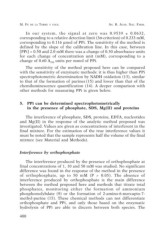Page 142 - 72_03
P. 142
M. FE DE LA TORRE Y COLS. AN. R. ACAD. NAC. FARM.
In our system, the signal at zero was 0.9539 ± 0.0632,
corresponding to a relative detection limit (3s-criterion) of 0.233 mM,
corresponding to 0.116 µmol of PPi. The sensitivity of the method is
defined by the slope of the calibration line. In this case, between
[PPi] = 0.50 and 2.0 mM there was a change of 0.30 absorbance units
for each change of concentration unit (mM), corresponding to a
change of 0.60 A280 units per mmol of PPi.
The sensitivity of the method proposed here can be compared
with the sensitivity of enzymatic methods: it is thus higher than PPi
spectrophotometric determination by NADH oxidation (13), similar
to that of the formation of purines (15) and lower than that of the
chemiluminescence quantification (14). A deeper comparison with
other methods for measuring PPi is given below.
5. PPi can be determined spectrophotometrically
5. in the presence of phosphate, SDS, Mg(II) and proteins
The interference of phosphate, SDS, proteins, EDTA, nucleotides
and Mg(II) in the response of the analytic method proposed was
investigated. Values are given as concentrations of interferent in the
final mixture. For the estimation of the true interference values it
must be noted that the sample represents half the volume of the final
mixture (see Material and Methods).
Interference by orthophosphate
The interference produced by the presence of orthophosphate at
final concentrations of 1, 10 and 50 mM was studied. No significant
difference was found in the response of the method in the presence
of orthophosphate, up to 50 mM (P > 0.05). The absence of
interference produced by orthophosphate is the main difference
between the method proposed here and methods that titrate total
phosphates, monitoring either the formation of ammonium
phosphomolybdate (9) or the formation of 2-amino-6-mercapto-7-
methyl-purine (15). These chemical methods can not differentiate
orthophosphate and PPi, and only those based on the enzymatic
hydrolysis of PPi are able to discern between both species. The
480

